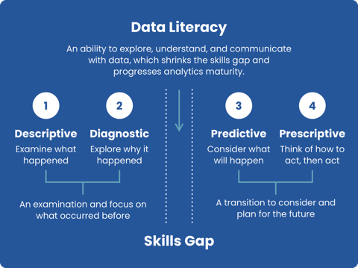
Data Literacy and Analytics: Where Do They Intersect?
By Tanaaz Khan
The Current State of Data Usage
Gone are the days when organizations focused exclusively on big data, which required gathering as much data as possible in the shortest period. This approach led to an increase in data volume but with minimal business benefits. The issue? The data was either irrelevant to their overarching business goals or inaccessible to the users. Now, companies are in a situation where they either have the data and don’t know what to do with it – or they know what to do but don’t have the relevant data to move forward.

Even when employees have access to analyzed insights, they can’t communicate the business benefits. To do this, we need to understand where the skills gap exists. There are four levels of analytics maturity:
- Descriptive: You examine what has happened before
- Diagnostic: You identify why it happened the way it did
- Predictive: Think about what might happen once you have the data
- Prescriptive: Think about what you need to do and how to do it
There’s a massive gap between the diagnostic and predictive stages, where the need for data literacy arises. If organizations can address this skills gap, they can move on to the prescriptive stage, where the most successful data-driven organizations now sit. But if they want to achieve this, they need to invest in programs that convince internal teams about the benefits of data literacy.
According to Tim Panagos, CTO and co-founder of Microshare:
“This cycle is self-reinforcing: Data literacy and data analytics do fuel each other. More ROI leads to more belief, which leads to more action, which leads to more ROI, and so on. The trick with all such ‘virtuous cycles’ is to kick them off in the right direction and let the cycle do the rest of the work.”
